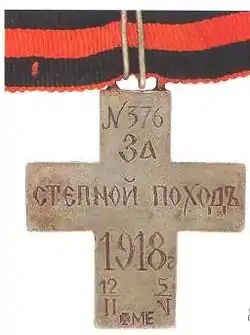Steppe March
The Steppe March (Russian: Степной поход) was a successful military withdrawal by the Don Cossacks in Spring 1918, towards the steppe around the Sal River, to ensure their survival under attack from the Red Army.
| Steppe March | |||||||
|---|---|---|---|---|---|---|---|
| Part of the Southern Front of the Russian Civil War | |||||||
 Steppe March medal | |||||||
| |||||||
| Belligerents | |||||||
|
|
| ||||||
| Commanders and leaders | |||||||
|
|
| ||||||
| Strength | |||||||
| 1,727 | unknown | ||||||
| Casualties and losses | |||||||
| 81 men | unknown | ||||||
In January-February 1918, the Red Army had conducted the successful Donbass-Don Operation in which Rostov-on-Don was occupied on February 23, and the Cossack capital Novocherkassk on February 25. The Don Cossack Ataman Alexei Kaledin committed suicide on 11 February 1918.
Parts of the White Volunteer Army under the command of Generals Mikhail Alekseev and General Lavr Kornilov retreated during the Ice March to the Kuban. The Don Cossacks didn't want to leave the Don and their native lands, and didn't join the Ice March towards the Kuban.
A detachment of 1,727 volunteers was formed under the command of Major-General Piotr Popov, with 5 pieces of artillery and 39 machine guns. The Don Cossacks went instead to the steppes around the Sal River, where they could find enough supplies and fodder for the horses. The purpose of the operation was, while fighting the Bolsheviks, to ensure the existence of a hard core of the Don Army around which the Cossacks could regroup and take up arms.
The campaign ended in May 1918 with the Cossacks returning to Novocherkassk, now 3,000 men strong.
The city had been abandoned by the Bolsheviks under pressure of the German-Austrian advance and the arrival of Drozdovtsy detachment from Romania.
This campaign marked the beginning of Cossack armed resistance against the Red Army